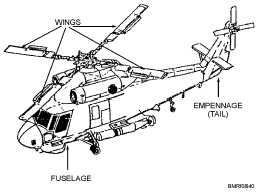the lift is generated by the rotation of the assembly,
which creates a flow of air over the blades.
A helicopter is lifted into the air by the aerodynamic
forces on the rotor and not pushed up by the downwash.
Some helicopters have twin rotors in tandem at either
end of the fuselage; but most have a single, main rotor
with a tail rotor mounted at right angles. A few have
tandem intermeshing rotors.
TAIL ROTOR.—The tail rotor is used for
directional control and stability. It is mounted at right
angles to the main rotor to counteract the torque of that
system. By varying the pitch of the tail rotor blades, the
pilot controls yaw.
Helicopter engines are connected to the rotor
shaft(s) by a transmission, which may be disengaged.
That permits the engine(s) to be operated on the ground
without engaging the rotor system and also permits a
mode of flight known as autorotation. If the engines
should stop while in flight, they can be disengaged; the
freewheeling action of the rotor will allow a slower
descent.
AIRCRAFT MODEL DESIGNATIONS
All aircraft have tri-service designations; that is, a
given aircraft has the same alphanumeric identification
symbol, regardless of which service uses the aircraft.
Look at table 8-2. Here, you can find the four basic parts
of an aircraft model designation.
8-34
Figure 8-40.—Rotary-wing aircraft.
Mission/type
modification symbol
Basic mission/type
symbol
Aircraft series
number
Model series
letter
A
Attack
A
Attack
These numbers are
assigned sequentially
within each basic mission
category. The number is
separated from the basic
mission symbol by a
dash.
This letter, added to the
series number, indicates an
improvement or alteration
of the basic mode. These
are assigned in sequence;
for example: F-4A, F-4B,
F-4C, and so forth.
C
Cargo/transport
B
Bomber
D
Drone control
C
Cargo/transport
E
Special electronics
E
Special electronics
H
Search and rescue
F
Fighter
K
Tanker
H
Helicopter
L
Cold weather
operations
K
Tanker
M
Missile capability
O
Observation
O
Observation
P
Patrol
Q
Drone
S
Antisubmarine
R
Reconnaissance
T
Trainer
S
Antisubmarine
U
Utility
T
Trainer
V
Vertical takeoff and
landing (VTOL)/short
takeoff and landing
(STOL)
U
Utility
X
Research
V
Staff transport
W
Weather
reconnaissance
Table 8-2.—Aircraft Model Designations



